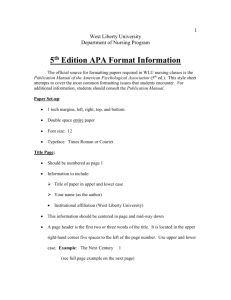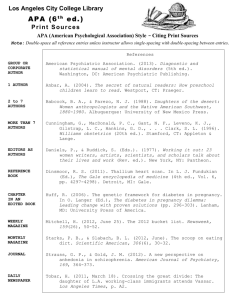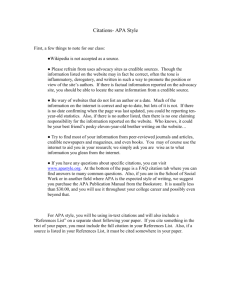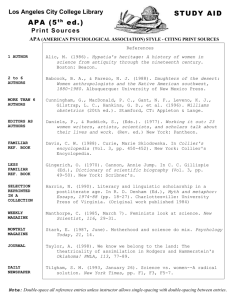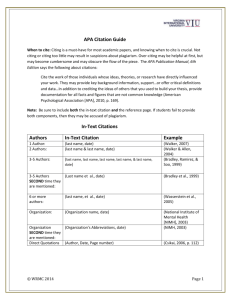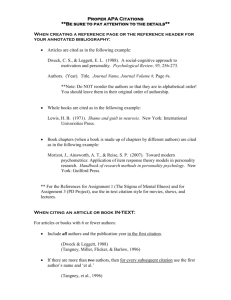APA 6th EDITION - West Liberty University
advertisement
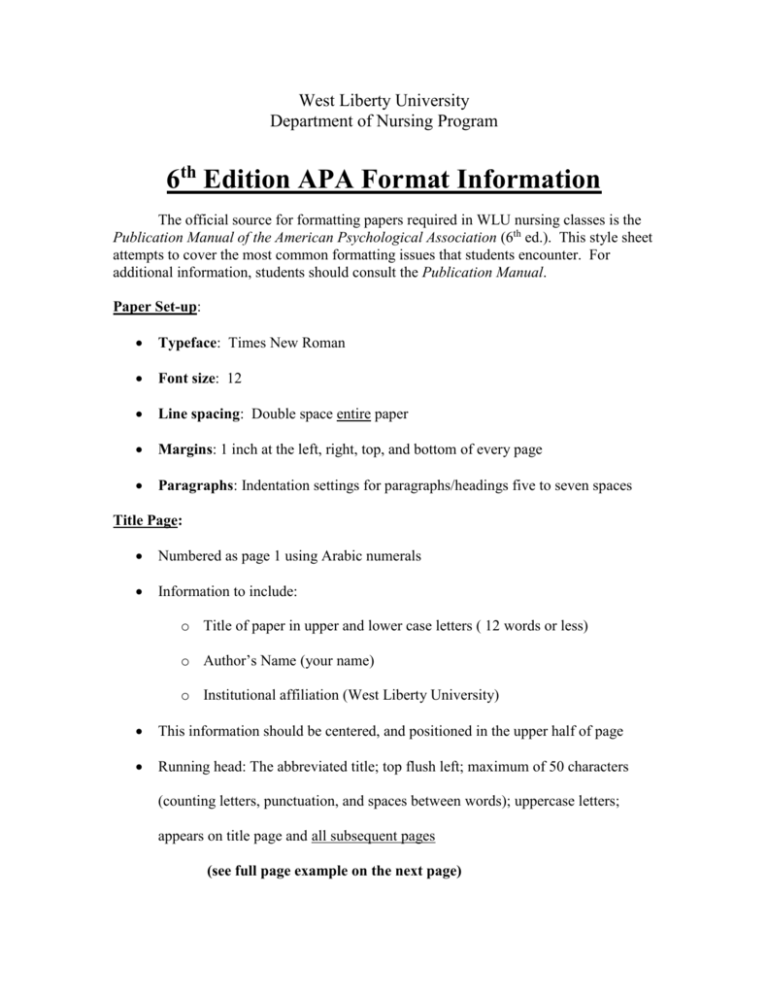
West Liberty University Department of Nursing Program 6th Edition APA Format Information The official source for formatting papers required in WLU nursing classes is the Publication Manual of the American Psychological Association (6th ed.). This style sheet attempts to cover the most common formatting issues that students encounter. For additional information, students should consult the Publication Manual. Paper Set-up: Typeface: Times New Roman Font size: 12 Line spacing: Double space entire paper Margins: 1 inch at the left, right, top, and bottom of every page Paragraphs: Indentation settings for paragraphs/headings five to seven spaces Title Page: Numbered as page 1 using Arabic numerals Information to include: o Title of paper in upper and lower case letters ( 12 words or less) o Author’s Name (your name) o Institutional affiliation (West Liberty University) This information should be centered, and positioned in the upper half of page Running head: The abbreviated title; top flush left; maximum of 50 characters (counting letters, punctuation, and spaces between words); uppercase letters; appears on title page and all subsequent pages (see full page example on the next page) Running head: EFFECTS ON NURSING BY COMPETENCY RULES Effects on Nursing by the Competency Rules of Accrediting Bodies Mary Anne Harkins West Liberty University 1 3 Heading Levels: (Ways to organize subject matter) The Introduction does not need a “Heading” With 1, 2, or 3 levels use the following examples: Level one: Centered, Boldface, Uppercase and Lowercase Words Example: The Pathophysiology of Pancreatitis In assessing the patient with acute pancreatitis, it is necessary to understand the pathophysiology behind the signs and symptoms. Pancreatic enzymes are inappropriately activated within the pancreas. Therefore, inappropriate breakdown of fats, proteins, and carbohydrates occur within the pancreas itself………………………………… Level two: Flush left, Boldface, Uppercase and Lowercase Words Example: Associated Signs and Symptoms The hallmark symptom of acute pancreatitis is persistent abdominal pain that is not relieved by vomiting. Signs of hypovolemia also accompany the abdominal pain….. Level three: Indented, Boldface, lowercase except for the first word and with a period at the end of the heading, then continue content 2 spaces after the period. Example: Supportive measures. Supportive measures include pain management, aggressive fluid replacement, and psychological support. 4 Body of Work: (Basic Rules) A good general rule in writing is that you always include and introduction of the content and end with a conclusion or summary of the content, even when not specifically asked. Do not leave a heading only at the bottom of a page. It should be taken to the next page. If you start a new paragraph on the bottom of a page – do not leave only one line. That line should be taken to the next page. Do not carry only the last line of a paragraph to a new page. Carry at least two lines. Paragraphs must be at least three sentences. Please proof read work for grammar and content. APA rules on the use of numbers: Use the digit for numbers 10 and above. (e.g., 33) Use the words for numbers less than 10. (e.g., nine) Use numbers when they are followed by a unit of measurement. (e.g., 5 mg) Use the number with other numbers grouped in a sentence with numbers greater than 10 or above. (e.g., there were 7 blocks…………..in 12 blocks) Use numbers that denote a specific place in a numbered series (books, volumes, table) (e.g., Trial 3, Chapter 5) Use numbers if they represents time, dates, age, sample size, exact money, etc. 5 Use words for numbers that begin a sentence, title or heading. Twenty Men of Honor Use words for common fractions. (e.g., one fifth of the class) Use numbers and not Roman numerals, unless specifically part of the title Referencing sources in text (citations) Direct Quotes: quotes that are fewer than 40 words: Example: Kertcher (2007) states, “The blood is not always bluer on the other side” (p. 125). Direct Quotes: quotes that are more than 40 words: freestanding block, all indent throughout, double space and omit the quotation marks. Example: Foster and Merritt (2009) found the following: The angels seemed to be perceived as glowing and floating about the air. However, when asked to describe a color, the participants often were unable to distinguish red, blue, purple, yellow, or white. As well, when asked if these entities moved or hovered, it seemed that they did neither yet was always just out of reach. (p. 58). 6 Paraphrasing: This is using your own words to summarize or explain another’s work. The author must be credited and the reference must appear in the reference list. Example: Rivers and Nigel (2008) discovered that the general feeling of the tribe was paternalistic. Example: The gender battle is neither old nor new in philosophy (Miles and Craig, 2009). Tables, charts, skill sheets, models, graphs, etc. must be cited in text. Direct Quotes (Basic Rules) When using a direct quote, always include the page number in which the quote came from. If there is no page number (for example a brochure or internet site), use the paragraph number in the citation. e.g., (Ckekler, 2008, para. 5). Personal Communications (Interviews): do not include in reference list. DO cite the person in text: Example: B. Jones (personal communication, February 20, 2009) referred to the standards of care for the patients. 7 In-text Citations (Basic Rules) With every citation include author and year. Once a citation has been made, you must cite the same source within the same paragraph with the author and year again. If there are 2 authors, always cite both If there are 3, 4, or 5 authors, cite all authors the first time, then with subsequent authors cite only the first author followed by et al., year Example: Smith et al., 2004 If there are 6 or more authors, cite only the last name of the first author followed by et al., and the year for all citations. If a group serves as an author (corporation, associations, etc.), spell out the group name each time or if it is a well known abbreviation cite the following: Example: (National Institute of Mental Health (NIMH, 2008) And then abbreviate it thereafter as NIMH (2008) If there are no authors, move the title to the author position, and alphabetize the first word of the title and the year. If the author is “Anonymous” begin the entry with the word Anonymous spelled out and alphabetize the entry as if a true name. 8 Citation of a work discussed in a secondary source: Give the secondary source in the reference list; in text, name the original work, and give a citation for the secondary source. Example: If Seidenberg and McClelland’s work is cited in Coltheart et al. and you did not read the work cited, list the Coltheart et al. reference in the References. In the text, use the following citation as an example: Seidenberg and McClelland’s study (as cited in Coltheart, Curtis, Atkins, & Haller, 2009) explores the dual-route and parallel-distributed processing approach to client interviewing. Reference List vs Bibliography: A reference list cites work that specifically supports the content of your work. A bibliography cites and includes work that is used for background and further reading. Every reference that is cited in text must appear in the reference list. Every entry in a reference list must be cited in-text. The reference list or Bibliography is to be double spaced and arrange entries in alphabetical order by last name of the first author. For entries with multiple authors, do not alter the order of the authors for the original text. The reference page is to be numbered and titled as References, two lines (or a double space) below the page number, and it is to be centered. 9 Regarding publisher location: Give city and state abbreviation according to U.S. Postal Service abbreviations if located in the United States. If located outside of the United States give city and country. Reference List Entries: Book with ONE Author: Gilster, P. (2008). Digital literacy. New York, NY: John Wiley & Sons. Book with MORE than One Author: Forell, C. A., & Matthews, D. M. (2009). A law of her own: The reasonable woman as a measure of man. New York, NY: New York University Press. Book with Editions: Huskey, T., & Maury, J. (2007). We must talk to hear ourselves: The introduction to listening skills (2nd ed.). New York, NY: McGraw-Hill. Brochure, corporate author: U.S. Department of Health and Human Services, National Institutes of Health, National Heart, Lung, and Blood Institute. (2008). Managing asthma: A guide for schools (NIH Publication No. 02-1002). Washington, DC: Government Printing Office. Encyclopedia Reference (dictionaries, etc.), with no author listed: Special education. (2007). In The new encyclopaedia Britannica (Vol 11, pp. 75-76). Chicago, IL: Encyclopaedia Britannica. 10 Journal Article: Jones, J. J., & Fritter, R. L. (2005). The remaking of the organizational hierarchy in the millennium. Journal of Healthcare Management, 45 (2), 10-22. Magazine Article: Keller, R., Peters, K., & Knowlton, Y. (2005, November 10). Magnesium: The forgotten electrolyte. Science Magazine, 220, 999-1002. Newspaper Article: Many doctors shun patients with Medicare. (2005, March 17). The New York Times, p. A1. Schwartz, J. (2007, September 30). Obesity affects economic, social status. The Washington Post, pp. A1, A4. Online Article: Begley, S., Underwood, A., Springen, K., & Gesalman, A. (2007). The schizophrenic mind. Newsweek, 139(10), 44-57. Retrieved from http://search.epnet.com Web Site: B-type naturetic peptide in congestive heart failure (2008, October). Retrieved from http://www.bnpchf.org/elecref.html Online Reference Work (Encyclopedia, dictionary, etc.) with author Hutchinson, M. (2008). Hydrocephalus. In Deluxe (Ed.). The New American encyclopedia (Fall 2009 ed.). Retrieved from http://enclyopedia.stanford.edu/hydrocephalus/ 11 Online Reference Work (Encyclopedia, dictionary, etc.) no author or editor Hydrocephalus. (n.d.). In Merriam-Webster’s online dictionary (11th ed.). Retrieved from http://www.m-w.com/dictionary/hydrocephalus ADDITIONAL ADVISE: Use only refereed (Professional, credible) sources. When in doubt—check it out (with a Faculty member). For additional 6th Edition APA style information, refer to the Publication Manual of the American Psychological Association OR use the following website: http://owl.english.purdue.edu According to the Publication Manual of the American Psychological Association (APA Ethics Code Standard 8:11) researchers/authors/writers do not claim the words and ideas of another as their own; they give credit where credit is due. To not follow this code is PLAGIARISM. Revised 1/2010 Reviewed
